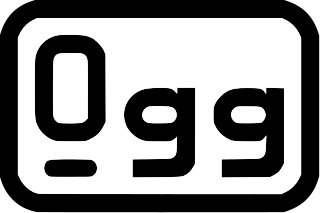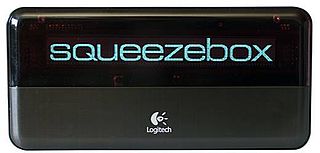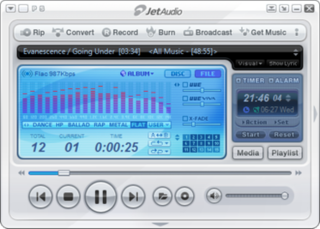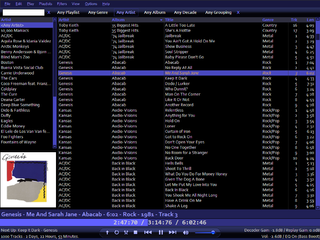
Ogg is a free, open container format maintained by the Xiph.Org Foundation. The authors of the Ogg format state that it is unrestricted by software patents and is designed to provide for efficient streaming and manipulation of high-quality digital multimedia. Its name is derived from "ogging", jargon from the computer game Netrek.

Vorbis is a free and open-source software project headed by the Xiph.Org Foundation. The project produces an audio coding format and software reference encoder/decoder (codec) for lossy audio compression. Vorbis is most commonly used in conjunction with the Ogg container format and it is therefore often referred to as Ogg Vorbis.

Winamp is a media player for Microsoft Windows originally developed by Justin Frankel and Dmitry Boldyrev by their company Nullsoft, which they later sold to AOL in 1999 for $80 million. It was then acquired by Radionomy in 2014. Since version 2 it has been sold as freemium and supports extensibility with plug-ins and skins, and features music visualization, playlist and a media library, supported by a large online community.
foobar2000 is a freeware audio player for Microsoft Windows, iOS and Android developed by Peter Pawłowski. It has a modular design, which provides user flexibility in configuration and customization. Standard "skin" elements can be individually augmented or replaced with different dials and buttons, as well as visualizers such as waveform, oscilloscope, spectrum, spectrogram (waterfall), peak and smoothed VU meters. foobar2000 offers third-party user interface modifications through a software development kit (SDK).

RealPlayer, formerly RealAudio Player, RealOne Player and RealPlayer G2, is a cross-platform media player app, developed by RealNetworks. The media player is compatible with numerous container file formats of the multimedia realm, including MP3, MP4, QuickTime File Format, Windows Media format, and the proprietary RealAudio and RealVideo formats. RealPlayer is also available for other operating systems; Linux, Unix, Palm OS, Windows Mobile, and Symbian versions have been released.
ReplayGain is a proposed technical standard published by David Robinson in 2001 to measure and normalize the perceived loudness of audio in computer audio formats such as MP3 and Ogg Vorbis. It allows media players to normalize loudness for individual tracks or albums. This avoids the common problem of having to manually adjust volume levels between tracks when playing audio files from albums that have been mastered at different loudness levels.

Rockbox is a free and open-source software replacement for the OEM firmware in various forms of digital audio players (DAPs) with an original kernel. It offers an alternative to the player's operating system, in many cases without removing the original firmware, which provides a plug-in architecture for adding various enhancements and functions. Enhancements include personal digital assistant (PDA) functions, applications, utilities, and games. Rockbox can also retrofit video playback functions on players first released in mid-2000. Rockbox includes a voice-driven user-interface suitable for operation by visually impaired users.

musikcube is a free and open-source cross-platform, terminal-based audio player software and streaming server.
Gapless playback is the uninterrupted playback of consecutive audio tracks, such that relative time distances in the original audio source are preserved over track boundaries on playback. For this to be useful, other artifacts at track boundaries should not be severed either. Gapless playback is common with compact discs, gramophone records, or tapes, but is not always available with other formats that employ compressed digital audio. The absence of gapless playback is a source of annoyance to listeners of music where tracks are meant to segue into each other, such as some classical music, progressive rock, concept albums, electronic music, and live recordings with audience noise between tracks.

The Rio Karma is a digital audio player originally made by the now-defunct Rio. It was released in August 2003. It measures 2.7 × 3 × 0.9 inches and weighs 5.5 ounces. It has a 20 gigabyte hard drive. The Karma is notable for its support of Ogg Vorbis and FLAC playback in addition to the usual MP3 and WMA formats, however it will not play MP2 format. It also bears the distinction of supporting file transfers via Ethernet through its docking station, as well as the standard USB 2.0. It is not supported as a plug and play removable drive, although the program Rio Taxi does allow any data to be stored. Like many Rio players, the Karma's firmware features a 5-band parametric equalizer, cross-fader, true gapless playback, animated menus, dynamic playlist generation and visualizations.

Squeezebox is a family of network music players. The original device was the SliMP3, introduced in 2001 by Slim Devices. It had an Ethernet interface and played MP3 music files from a media server. The first Squeezebox was released two years later and was followed by several more models. Slim Devices was acquired by Logitech in 2006.

Audacious is a free and open-source audio player software with a focus on low resource use, high audio quality, and support for a wide range of audio formats. It is designed primarily for use on POSIX-compatible Unix-like operating systems, with limited support for Microsoft Windows. Audacious is the default audio player in Lubuntu and Ubuntu Studio.
Total Recorder is digital audio editor software from High Criteria, Inc. which is able to record any sound coming through a computer soundcard. In addition to recording through a soundcard, Total Recorder is able to record digital sound directly through its virtual sound driver. This driver provides an advantage of recording audio reproduced by an external program directly in digital format, i.e. without digital-analog-digital conversions leading to loss of quality, and even in those cases when a computer soundcard has no loop-back line. Total Recorder is a shareware program. Evaluation version of Total Recorder is a fully functional version of the program, with the exception that an audible noise will be inserted about every 60 seconds.

JetAudio is a shareware media player application for Microsoft Windows and Android which offers advanced playback options for a wide range of multimedia file formats.

MusicBee is a freeware media player for playback and organization of audio files on Microsoft Windows, built using the BASS audio library.

Clementine is a free and open-source audio player. It is a port of Amarok 1.4 to the Qt 4 framework and the GStreamer multimedia framework. It is available for Unix-like, Windows and macOS operating systems. Clementine is released under the terms of the GPL-3.0-or-later.

QuuxPlayer is a freeware audio player for Windows developed by Matthew Hamilton of Quux Software. It is designed principally for sound quality, simplicity and ease of use. QuuxPlayer can support large music libraries of 100,000 tracks or more, with the ability to load up to 30,000 tracks per minute. It also provides a tag editor, automatic downloads of album details, lyrics and reviews, and support for Internet radio and podcasts.

AIMP is a freeware audio player for Windows and Android, originally developed by Russian developer Artem Izmaylov.
XMPlay is a freeware audio player for Windows. Initially released in 1998, it is often used as a reference player for tracker audio files.













